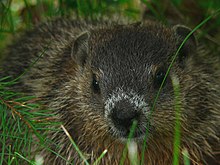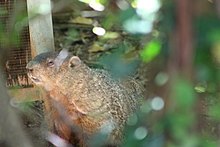| Revision as of 19:46, 25 April 2009 edit70.222.176.82 (talk) →Anatomy and behavior← Previous edit | Revision as of 20:06, 28 April 2009 edit undo143.229.177.59 (talk)No edit summaryNext edit → | ||
| Line 19: | Line 19: | ||
| }} | }} | ||
| The '''groundhog''' (''Marmota monax''), also known as '''woodchuck,''' '''land beaver''' or ''' |
The '''groundhog''' (''Marmota monax''), also known as '''woodchuck,''' '''land beaver,''' '''whistlepig''' or '''Womp-Womp''', is a ] of the family ], belonging to the group of large ground ]s known as ]s. Other marmots, such as the ] and ], live in rocky and mountainous areas, but the woodchuck is a lowland creature. It is widely distributed in ] and common in the northeastern and central ]. Groundhogs are found as far north as ], with their habitat extending southeast to ].<ref>http://pick4.pick.uga.edu/nh/tx/Vertebrata/Mammalia/Sciuridae/Marmota/monax/</ref> | ||
| == Anatomy and behavior == | == Anatomy and behavior == | ||
Revision as of 20:06, 28 April 2009
"Groundhogs" redirects here. For the rock band, see The Groundhogs.| Groundhog/ Woodchuck | |
|---|---|

| |
| Conservation status | |
 Least Concern (IUCN 3.1) | |
| Scientific classification | |
| Kingdom: | Animalia |
| Phylum: | Chordata |
| Class: | Mammalia |
| Order: | Rodentia |
| Family: | Sciuridae |
| Genus: | Marmota |
| Species: | M. monax |
| Binomial name | |
| Marmota monax (Linnaeus, 1758 | |
The groundhog (Marmota monax), also known as woodchuck, land beaver, whistlepig or Womp-Womp, is a rodent of the family Sciuridae, belonging to the group of large ground squirrels known as marmots. Other marmots, such as the yellow-bellied and hoary marmots, live in rocky and mountainous areas, but the woodchuck is a lowland creature. It is widely distributed in North America and common in the northeastern and central United States. Groundhogs are found as far north as Alaska, with their habitat extending southeast to Alabama.
Anatomy and behavior




The groundhog is the largest sciurid in its geographical range, typically measuring 40 to 65 cm (17 to 26 in) long (including a 15 cm tail) and weighing 2 to 4 kg (4.5 to 9 pounds). In areas with fewer natural predators and large quantities of alfalfa, groundhogs can grow to 80 cm (32 in) and 14 kg (30 lb). Groundhogs are well adapted for digging, with short but powerful limbs and curved, thick claws. Unlike other sciurids, the groundhog's spine is curved, more like that of a mole, and the tail is comparably shorter as well – only about one-fourth of body length. Suited to their temperate habitat, groundhogs are covered with two coats of fur: a dense grey undercoat and a longer coat of banded guard hairs that gives the groundhog its distinctive "frosted" appearance.
Groundhogs usually live from two to three years, but can live up to six years in the wild. In captivity, groundhogs can exceed this limit; by example, the 22-year-old Wiarton Willie may indicate the maximum lifespan. Common predators for groundhogs include wolves, coyotes, foxes, bobcats, bears, large hawks, owls and dogs. Young groundhogs are often at risk for predation by snakes, which easily enter the burrow.
Mostly herbivorous, groundhogs primarily eat wild grasses and other vegetation, and berries and agricultural crops when available. Groundhogs also eat grubs, grasshoppers, insects, snails and other small animals, but are not as omnivorous as many other sciurids.
Groundhogs are excellent burrowers, using burrows for sleeping, rearing young, and hibernating. The average groundhog has been estimated to move approximately 1 m³ (35 cubic feet), or 320 kg (700 pounds), of dirt when digging a burrow. Though groundhogs are the most solitary of the marmots, several individuals may occupy the same burrow. Groundhog burrows usually have two to five entrances, providing groundhogs their primary means of escape from predators. Burrows are particularly large, with up to 45 feet (14 m) of tunnels buried up to 5 feet (1.5 m) underground, and can pose a serious threat to agricultural and residential development by damaging farm machinery and even undermining building foundations.
Groundhogs are one of the few species that enter into true hibernation, and often build a separate "winter burrow" for this purpose. This burrow is usually in a wooded or brushy area and is dug below the frost line and remains at a stable temperature well above freezing during the winter months. In most areas, groundhogs hibernate from October to March or April, but in more temperate areas, they may hibernate as little as 3 months. To survive the winter, they are at their maximum weight shortly before entering hibernation. They emerge from hibernation with some remaining body fat to live on until the warmer spring weather produces abundant plant materials for food.
Despite their heavy-bodied appearance, groundhogs are accomplished swimmers and climbers, and climb trees to escape predators or survey their surroundings. They prefer to retreat to their burrows when threatened; if the burrow is invaded, the groundhog tenaciously defends itself with its two large incisors and front claws. Groundhogs are generally agonistic and territorial among their own species, and may skirmish to establish dominance.
Outside their burrow, individuals are alert when not actively feeding. It is common to see one or more nearly-motionless individuals standing erect on their hind feet watching for danger. When alarmed, they use a high-pitched whistle to warn the rest of the colony. Groundhogs may squeal when fighting, seriously injured, or caught by an enemy. Other sounds groundhogs may make are low barks and a sound produced by grinding their teeth.
Usually groundhogs breed in their second year, but a small proportion may breed in their first. The breeding season extends from early March to mid- or late April, after hibernation. A mated pair remains in the same den throughout the 28-32 day gestation period. As birth of the young approaches in April or May, the male leaves the den. One litter is produced annually, usually containing 2-6 blind, hairless and helpless young. Young groundhogs are weaned and ready to seek their own dens at five to six weeks of age.
The groundhog prefers open country and the edges of woodland, and it is rarely far from a burrow entrance. Since the clearing of forests provided it with much more suitable habitat, the groundhog population is probably higher now than it was before the arrival of European settlers in North America. Groundhogs are often hunted for sport, which tends to control their numbers. However, their ability to reproduce quickly has tended to mitigate the depopulating effects of sport hunting. As a consequence, the groundhog is a familiar animal to many people in the United States and Canada.
Groundhogs raised in captivity can be socialized relatively easily; however, their aggressive nature can pose problems. Doug Schwartz, a zookeeper and groundhog trainer at the Staten Island Zoo, has been quoted as saying "They’re known for their aggression, so you’re starting from a hard place. natural impulse is to kill ’em all and let God sort ’em out. You have to work to produce the sweet and cuddly."
Human relevance

In the United States and Canada, the yearly Groundhog Day celebration has given the groundhog recognition and popularity, as has the movie of the same name. The most popularly known of these groundhogs are Wiarton Willie and Punxsutawney Phil, well kept as part of Groundhog Day festivities in Wiarton, Ontario and Punxsutawney, Pennsylvania, respectively.
The etymology of the name woodchuck is unrelated to wood or chucking. It stems from an Algonquian name for the animal (possibly Narragansett), wuchak. The apparent relationship between the two words has led to the common tongue twister: "How much wood would a woodchuck chuck if a woodchuck could chuck wood?". Various response lines can answer this, including:
- "As much wood as a woodchuck would if a woodchuck could chuck wood."
- "A woodchuck would chuck as much wood as a woodchuck could chuck, if a woodchuck could chuck wood."
- "A woodchuck would chuck all the wood, if a woodchuck only could."
References
- Template:IUCN2008
- http://pick4.pick.uga.edu/nh/tx/Vertebrata/Mammalia/Sciuridae/Marmota/monax/
- ^ Whitaker, John O (1998). Mammals of the Eastern United States. Cornell University Press. ISBN 0801434750.
{{cite book}}: Unknown parameter|coauthors=ignored (|author=suggested) (help) - ^ Animal Diversity Web : Marmota monax (University of Michigan Museum of Zoology)
- Woodchucks in Rhode Island (Rhode Island Department of Environmental Management)
- Chapman, J.A. (1982). Wild Mammals of North America, Biology, Management, Economics. Johns Hopkins University Press.
{{cite book}}: Unknown parameter|coauthors=ignored (|author=suggested) (help) - ^ Hinterland Who's Who ("Canadian Wildlife Service: Mammals: Woodchuck")
- Andy Newman, Grooming a Weatherman for His TV Debut, and Hoping He Doesn't Bite the Host. New York Times, January 12 2007]
- Jackie Silberg (2003), The Learning Power of Laughter, Page 23
- Laura Rountree Smith (1923), Two Hundred Games that Teach, Page 63
- The Writer's Forum, The Coffee Shop,
External links
- Hinterland Who's Who ("Canadian Wildlife Service: Mammals: Woodchuck")
- Missouri Conservation Commission ("Woodchuck")